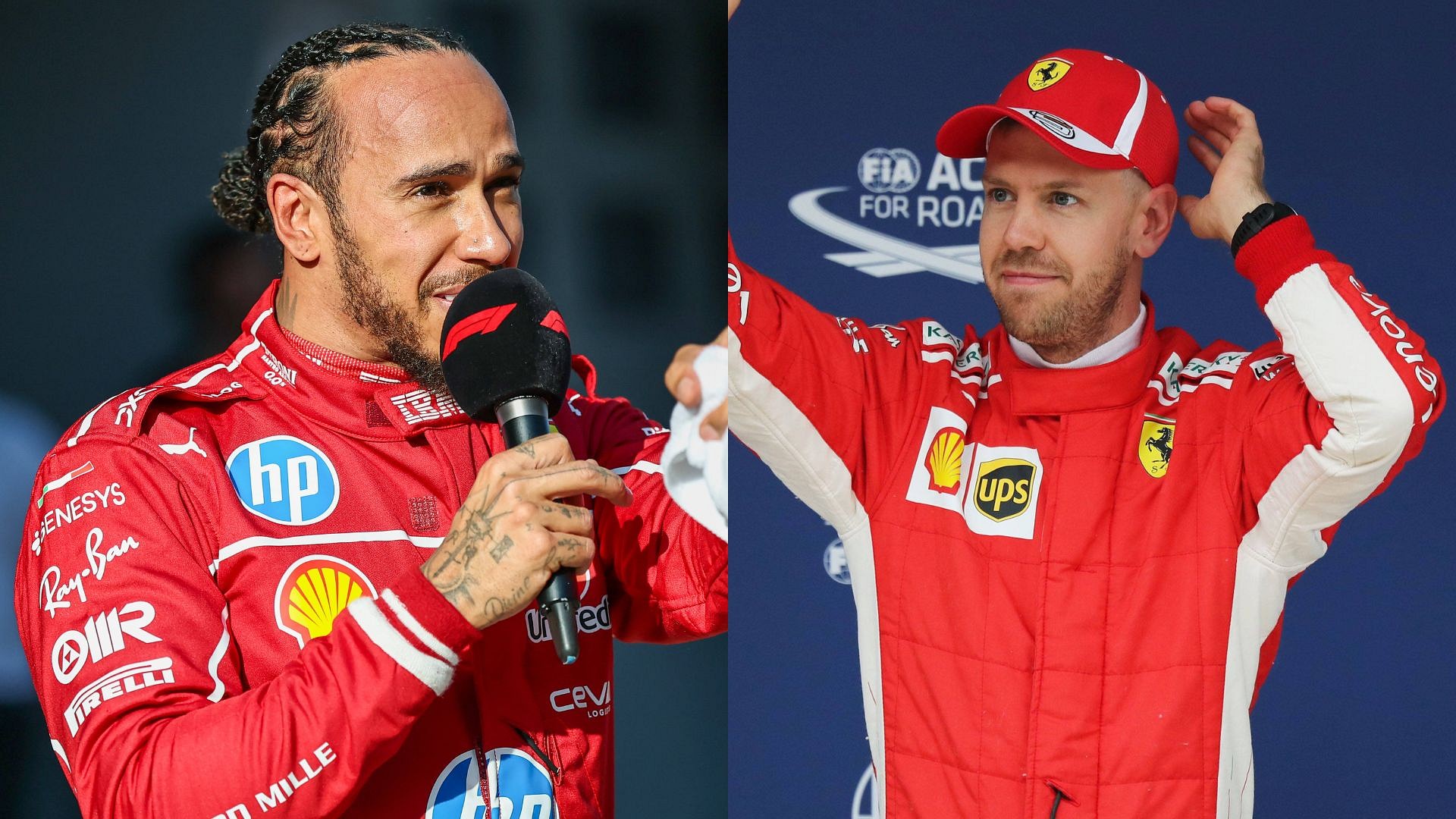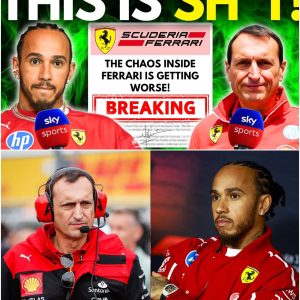When Lewis Hamilton signed the contract that would put him in Ferrari red, the story seemed too perfect to fail. A seven-time world champion, the face of modern Formula 1, taking on the most romantic challenge in motorsport — to revive Ferrari and write the final chapter of his career in scarlet glory. It was meant to be a move for the ages.
But in Budapest, the narrative flipped. Instead of silencing the whispers that his Ferrari gamble was a miscalculation, Hamilton delivered his most jarring performance yet in the SF-25. On a day when Charles Leclerc electrified the timing sheets and secured Ferrari’s first pole position of the 2025 season, Hamilton could do no better than 12th. And worse than the result were his words: he called himself “useless,” questioned whether Ferrari would be better off replacing him, and hinted at background issues within Maranello that weren’t going away.
For a seven-time world champion at 40 years old, the sight was sobering. Hamilton didn’t just look beaten; he looked vulnerable. And the comparison that many had been avoiding suddenly became unavoidable: Sebastian Vettel in 2019 — another champion adrift in a Ferrari shaped around Leclerc’s hands.
Echoes of Vettel
Sebastian Vettel arrived at Ferrari in 2015 with the dream of restoring the Scuderia to its former glory. But by 2019, when Leclerc entered the team and immediately thrived, Vettel was left looking like a stranger in his own car. He struggled to adapt to Leclerc’s preference for a free, unstable rear end — a car that danced under braking and rotated aggressively into corners. Vettel tried to mimic that style, softening the front and loosening the rear. The result was clumsy, error-strewn performances that slowly eroded his confidence and reputation.
Now, Hamilton finds himself walking that same tightrope. Former Ferrari mechanic Francesco Cigarini believes history is repeating itself. He sees Leclerc dictating the team’s setup philosophy while Hamilton — like Vettel before him — battles a car concept that resists his natural instincts. His advice to Hamilton was blunt: “Call Vettel. Learn from the man who lived this exact nightmare.”
But here’s the twist. Unlike Vettel, Hamilton isn’t simply chasing Leclerc’s setup sheets. According to Italian reports, he’s veered in the opposite direction entirely, experimenting with shock absorbers, anti-roll bar stiffness, and wing levels that Ferrari engineers themselves call “not optimal.” In Budapest, the result was brutal: nearly a full second adrift of Leclerc in qualifying.

A Clash of Philosophies
At Mercedes, Hamilton had spent nearly a decade shaping a car around his driving DNA. His feedback carried weight, his style defined the design direction, and the team worked in harmony with his instincts. At Ferrari, the house is already built around Leclerc — a driver who has grown up inside the Scuderia, adapting to its quirks and thriving in its inconsistencies.
This has led to what insiders describe as a philosophical rift. While Leclerc pushes within Ferrari’s established aerodynamic and suspension baseline, Hamilton seems intent on carving his own path, even if it means venturing into experimental setups the engineers view as incompatible with the SF-25’s design.
That unpredictability has created tension within the garage. Engineers like consistency — it helps them model tire degradation, simulate strategies, and plan for race day. With Leclerc, they know what to expect. With Hamilton, the variables multiply. Even Riccardo Adami, Hamilton’s race engineer and the same man who guided Vettel through his Ferrari struggles, has found himself caught between respecting Hamilton’s champion instincts and reining in experiments that disrupt the team’s rhythm.
The Human Story Behind the Struggles
What makes Hamilton’s Ferrari story compelling isn’t just the technical gap to Leclerc. It’s the human dimension — the psychological unraveling of a driver who has spent a career projecting invincibility. For the first time in more than a decade, Hamilton has openly doubted himself. His self-assessments — “useless,” “maybe the team should replace me” — aren’t just soundbites; they’re cracks in the armor of a champion who has long thrived under pressure.
Formula 1 is as much mental warfare as it is mechanical competition. Once a driver begins to internalize failure, the spiral can accelerate. Vettel learned that the hard way. By the end of 2020, he was not just underperforming — he was an afterthought, released by Ferrari with little fanfare. Hamilton is painfully aware of that precedent. In fact, he reportedly called Vettel for advice even before his first Fiorano test. He adopted Vettel’s habit of keeping handwritten notebooks in pre-season. And yet, halfway through the season, he finds himself closer to reliving Vettel’s nightmare than rewriting it.

The Numbers Don’t Lie
Emotion aside, Formula 1 is ultimately judged in cold mathematics. Fourteen races into 2025, Leclerc’s pole positions and consistent top-five finishes have anchored Ferrari in the fight for second in the Constructors’ Championship. Hamilton, meanwhile, has yet to stand on the podium. For a team desperate to challenge Red Bull, that imbalance carries consequences.
Ferrari has always been unforgiving in its judgments. Fernando Alonso scored podiums but no titles. Vettel won races but was eclipsed by Leclerc’s consistency. Hamilton risks falling into the same category: a great champion whose numbers at Ferrari never matched the expectations.
Ripple Effects Across the Grid
Hamilton’s struggles don’t exist in isolation. At Mercedes, George Russell has stepped seamlessly into the leadership role, while young Andrea Kimi Antonelli is developing without the political weight that Hamilton once carried. At McLaren, Lando Norris and Oscar Piastri know that every point taken off Ferrari is amplified by Hamilton’s inconsistency. And at Red Bull, Max Verstappen relishes the chance not only to beat Hamilton but to dismantle the myth of Hamilton as an untouchable legend.
Ferrari’s internal split, in other words, is a gift to its rivals.
The Monza Test
The road ahead for Hamilton is narrowing. The next critical milestone is Monza — Ferrari’s home race, where expectations are unforgiving and the tifosi measure drivers not by excuses but by results. Leclerc arrives with momentum, confidence, and the full weight of the garage behind him. Hamilton arrives needing not just a good result, but a symbolic one. A podium at Monza could shift the narrative, proving he can lead Ferrari rather than merely survive inside it. Another failure, and the boos from the grandstands will echo louder than the cheers.
Looking Toward 2026
Ferrari’s focus is already shifting to Project 678, the car that will debut under the sweeping 2026 regulations. If Ferrari leans into Leclerc’s feedback while Hamilton struggles to adapt, the die may be cast before the new era begins. A car shaped around Leclerc could lock Hamilton into a secondary role by default — a reality no champion wants to face.
Redemption or Repetition?
Budapest will be remembered as the weekend Hamilton’s Ferrari adventure shifted from romance to reality. Twelfth on the grid, overshadowed by Leclerc’s pole, and describing himself as “useless,” Hamilton looked less like the savior Ferrari had been waiting for and more like another frustrated champion in Maranello’s long history.
The parallels with Vettel are impossible to ignore. Both faced the same dilemma: adapt or be left behind. But Hamilton’s challenge is sharper. Vettel was in his early 30s with a decade still ahead of him. Hamilton is 40, with a shrinking window to make this work.
The script is unwritten. If Hamilton bends toward Ferrari’s DNA and delivers, even a single symbolic result, his story could still swing toward redemption. If not, his Ferrari chapter risks becoming another tale of frustrated champions, destined to be remembered not for glory, but for what might have been.






